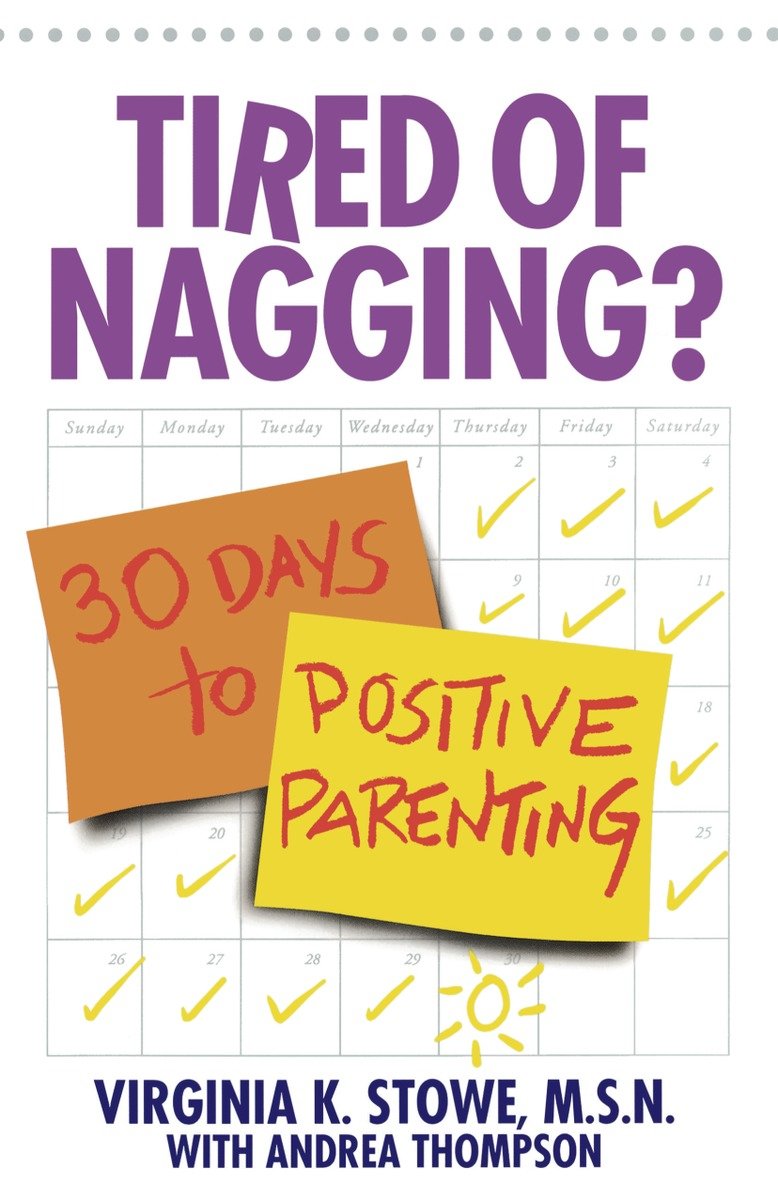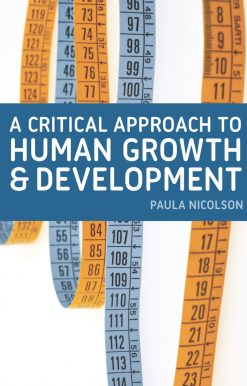Tired of Nagging?: 30 Days to Positive Parenting
12.00 JOD
Please allow 2 – 5 weeks for delivery of this item
Description
What do parents do when the child they adore won’t listen? They end up nagging, issuing orders, shouting, and sometimes even spanking. But there is a better way, and Virginia K. Stowe, a parent-child educator for more than twenty-five years, shows how to minimize friction and fighting within the household in order to maximize the pleasures of family life.Tired of Nagging? provides thirty easy-to-use tools for solving everyday conflicts, scenarios of commonplace power struggles and illustrations of the tools in action, plus an “ages and stages” guide to a child’s capabilities and needs. The readable, practical advice promotes a loving, yet firm approach, one that emphasizes working with the child to eliminate undesirable behavior without inhibiting self-esteem and independence. With Tired of Nagging?, parents can stop losing their patience and begin enjoying to the fullest all the laughter and fun of their child’s precious early years.
Additional information
| Weight | 0.31 kg |
|---|---|
| Dimensions | 1.27 × 13.97 × 21.59 cm |
| PubliCanadation City/Country | USA |
| by | |
| Format | Paperback |
| Language | |
| Pages | 228 |
| Publisher | |
| Year Published | 1998-6-1 |
| Imprint | |
| ISBN 10 | 0553379151 |
| Excerpt From Book | Chapter 1 TIRED OF NAGGING?: An Introduction. A 1½-YEAR-OLD, who normally loves going out for a leisurely walk, suddenly wants nothing to do with getting in her stroller. Mom wrestles her child in, amidst screams, kicks, and arching back. A 2-year-old refuses to take Dad’s hand as they’re walking to the park. Dad clamps on even tighter. As soon as he loosens his grip, off goes his toddler, gleefully running away while the frantic father charges after. A 3-year-old has demanded SpaghettiOs and fish sticks for dinner—then won’t eat. A 5-year-old thinks her parents are “so stupid,” and tells them so. Does any of that sound familiar? Have you been there? Preschool-aged children are wonderful and trying little human beings! As we watch them grow from squirming newborns to young children heading off for the first day of kindergarten, they enchant and delight us. And just as often, they drive us nuts. Why is it so hard to get them to do the simple things they need to do? Why do we get caught up in so many struggles all day long? What more do they want from us anyway? I know what you want, because it is what every parent wants: You want your child to behave in the ways that lead him steadily forward, toward his own life. You want him to learn to talk, dress himself, share his toys, play nicely with other children, use the toilet, not run into the street, accept what he has to do, challenge what seems wrong to him … and, in time, do his homework, be responsible to himself and others, leave home, get a job, get married. You want him to become independent. Here’s what your child wants: All those same things! He wants to get on with his own life. He wants to be independent. Since you and your youngster have the same goal, being a parent should be easy. As you know, however, it’s often not easy at all. WHAT HE DOES THAT YOU CAN’T STAND; WHAT YOU DO THAT YOU CAN’T STAND Growing up to the age of 5 is heady business. Your youngster in those years is learning (besides the walking, talking, eating, toileting basics) that some things are safe and some are dangerous, that Mom and Dad are perfect and then that Mom and Dad aren’t so perfect, that other kids exist in the world and sometimes they’re fun and sometimes they’re hateful, that he doesn’t know how to do a lot of things he wants to do, and on and on. All this, at times, makes him angry, frustrated, scared, exhausted, impetuous, or in some other way bothered by his current lot in life. Those feelings often lead to whining, dawdling, hitting, the “NO’s,” plain orneriness, and other (to you) unpleasant activities. But your child has to act in those ways. They are natural behaviors and they are not bad. They are what he uses to try to get what he wants or needs. They are also, of course, the kinds of behaviors that drive you up the wall and that make a lot of the time you spend with your child not as agreeable as you wish it would be. They are the kinds of behaviors that so easily lead you to act in ways that you don’t like and would prefer not to—nagging your child, being the policeman and issuing orders, sometimes losing it and shouting. DEMOCRACY AT WORK It is absolutely in your power to eliminate much of the whining, dawdling, demandingness, nagging, and yelling that interfere with the joy and pleasure you have in being a parent—and that make your child’s march toward independence more unruly, and perhaps less successful, than it need be. How to get more agreeably from here to there is what this book will show you. It represents, really, a democratic kind of child-raising. When you are overly permissive—when you give in to the demands or the dawdles—you give your power away to your child. He’s calling the shots. When you are overly authoritarian, you’re calling the shots—you keep all the power. In our democratic system, you share power with your child: Some times you insist that he behave in certain ways, even if he is not in a mood or finds it difficult to comply. Other times you honor his wishes or requests. PARENTING TOOLS OF THE TRADE: THE 30 ESSENTIALS Learning how to share the power is really what this book is about. First, understand where your child is at different stages in his young life, and that’s going to change and shift a lot over the course of these 5 years. Bring your expectations in line with his capabilities and needs, and you’ve made a major move toward reducing the struggles. The next section of this book gives you a quick-and-easy overview of these “ages and stages” from babyhood to age 5. Second, use parenting tools that work; that’s the focus of the central part of this book. You could just as easily call these skills or tips, but I like the idea of tools. It suggests something sturdy, useful, practical, enduring. There are 30 tools—all of them describing ways you can change your approach in order to promote in your youngster the behaviors you want from him. Some of them suggest small (or maybe they’ll be radical) shifts in the way you view your child, in how you see why he’s probably acting the way he’s acting. Some of them suggest changes in how you say things to your child or in how you spend time together. I’ll give you examples of the tools in action. I’ll use the most common kinds of behaviors (at each age) from your child that give you grief. And I’ll provide little miniscripts that suggest solutions. In most cases, you’ll want to use two or four or five tools. Of course, your own real-life interactions with your youngster won’t follow these scenarios word for word, but if you adapt the approaches to suit your child’s situation, you’ll be pleased at how often you get the results you’re after. MAKE THIS BOOK YOUR TRAVELING COMPANION Take Tired of Nagging? with you when you’re closing yourself in the bathroom for 15 minutes. Read a couple of pages while you’re waiting for the bus. Spend 15 minutes a day looking over some of the ideas presented here. Think of it, if you like, as a 30-day parenting shape-up course, and each day for one month take a few minutes reading about, thinking about, or trying out one of the 30 tools. You probably have a shelf full of child-raising guidebooks, big books that explore and explain all aspects of your child’s development. They have their place. Use the fat books for your backup, your encyclopedias, your reference library. Use this book as your traveling companion. I have kept it, I hope, easy to read and understand, because I’ve learned from the many mothers and fathers I’ve worked with in my twenty-five years as a parent-child educator that they too often feel overwhelmed by theory and analysis from the “experts.” I want this to be a simple little book that says, in effect: Perhaps this is what’s going on that’s making you struggle too much with your child, and perhaps this is what you can do differently to stop some of the struggles. When parents start to use these tools, they can’t get over how much more fun they have with their youngsters. They just are not struggling with their kids so much, even when those children are in their most difficult, most stubborn stages. The whole tone of family life shifts to a level where everyone is happier, where there’s a calmer, more cooperative spirit in the air. Try it—and you’ll see. |
Only logged in customers who have purchased this product may leave a review.






Reviews
There are no reviews yet.